2012 PEUGEOT 308 tow
[x] Cancel search: towPage 89 of 328
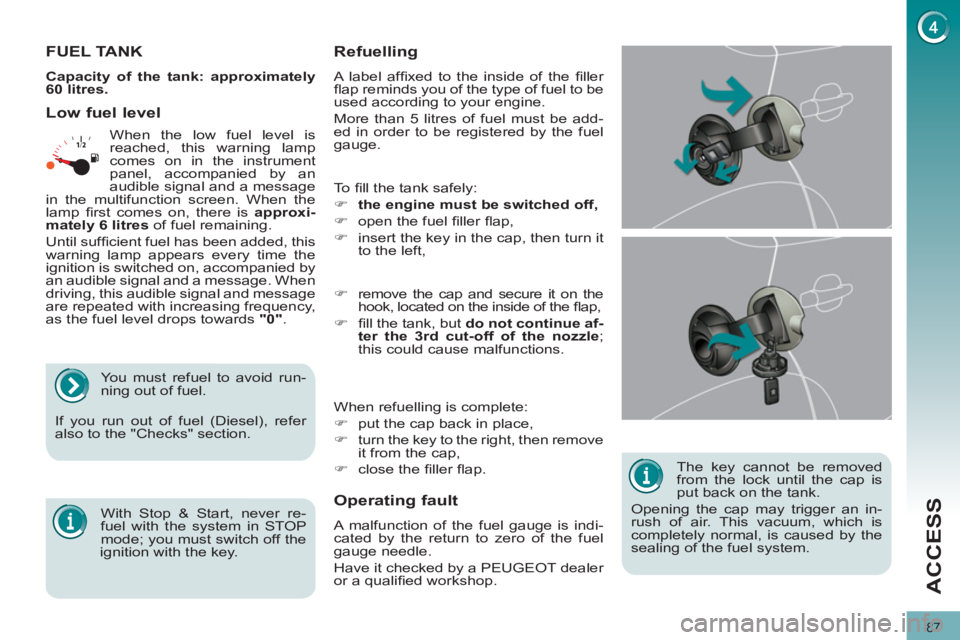
87
ACCESS
The key cannot be removed
from the lock until the cap is
put back on the tank.
Opening the cap may trigger an in-
rush of air. This vacuum, which is
completely normal, is caused by the
sealing of the fuel system.
FUEL TANK
Capacity of the tank: approximately
60 litres.
To fi ll the tank safely:
�)
the engine must be switched off,
�)
open the fuel fi ller fl ap,
�)
insert the key in the cap, then turn it
to the left,
When refuelling is complete:
�)
put the cap back in place,
�)
turn the key to the right, then remove
it from the cap,
�)
close the fi ller fl ap.
�)
remove the cap and secure it on the
hook, located on the inside of the fl ap,
�)
fi ll the tank, but do not continue af-
ter the 3rd cut-off of the nozzle
;
this could cause malfunctions.
Low fuel level
Operating fault
A malfunction of the fuel gauge is indi-
cated by the return to zero of the fuel
gauge needle.
Have it checked by a PEUGEOT dealer
or a qualifi ed workshop.
Refuelling
A label affi xed to the inside of the fi ller
fl ap reminds you of the type of fuel to be
used according to your engine.
More than 5 litres of fuel must be add-
ed in order to be registered by the fuel
gauge. When the low fuel level is
reached, this warning lamp
comes on in the instrument
panel, accompanied by an
audible signal and a message
in the multifunction screen. When the
lamp fi rst comes on, there is approxi-
mately
6 litres
of fuel remaining.
Until suffi cient fuel has been added, this
warning lamp appears every time the
ignition is switched on, accompanied by
an audible signal and a message. When
driving, this audible signal and message
are repeated with increasing frequency,
as the fuel level drops towards "0"
.
You must refuel to avoid run-
ning out of fuel.
If you run out of fuel (Diesel), refer
also to the "Checks" section.
With Stop & Start, never re-
fuel with the system in STOP
mode; you must switch off the
ignition with the key.
Page 91 of 328
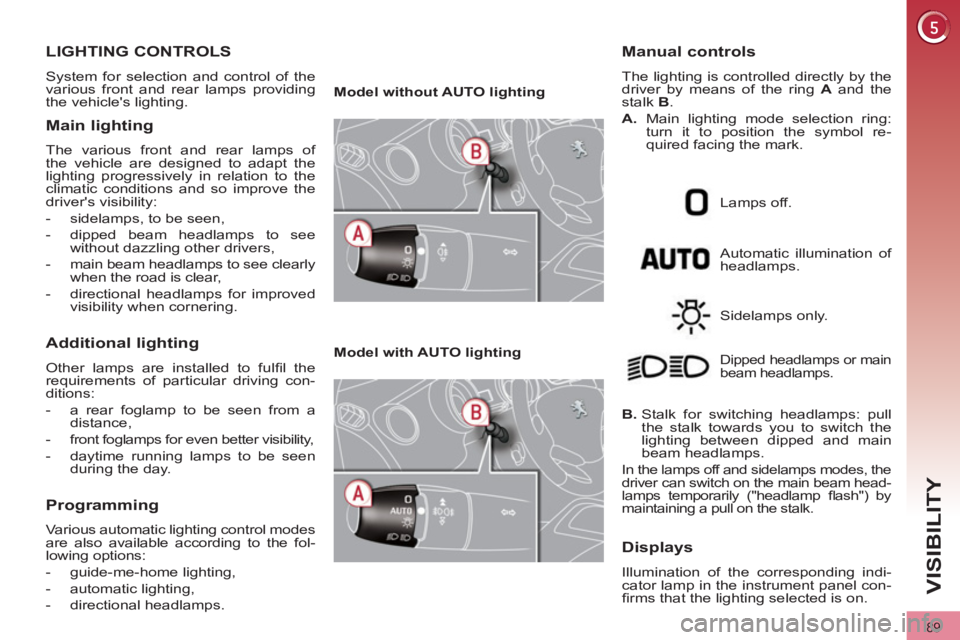
89
VISIBILITY
LIGHTING CONTROLS
System for selection and control of the
various front and rear lamps providing
the vehicle's lighting.
Main lighting
The various front and rear lamps of
the vehicle are designed to adapt the
lighting progressively in relation to the
climatic conditions and so improve the
driver's visibility:
- sidelamps, to be seen,
- dipped beam headlamps to see
without dazzling other drivers,
- main beam headlamps to see clearly
when the road is clear,
- directional headlamps for improved
visibility when cornering.
Additional lighting
Other lamps are installed to fulfi l the
requirements of particular driving con-
ditions:
- a rear foglamp to be seen from a
distance,
- front foglamps for even better visibility,
- daytime running lamps to be seen
during the day.
Programming
Various automatic lighting control modes
are also available according to the fol-
lowing options:
- guide-me-home lighting,
- automatic lighting,
- directional headlamps.
Model without AUTO lighting
Model with AUTO lighting
Automatic illumination of
headlamps.
Manual controls
The lighting is controlled directly by the
driver by means of the ring A
and the
stalk B
.
A.
Main lighting mode selection ring:
turn it to position the symbol re-
quired facing the mark.
Lamps off.
Sidelamps only.
B.
Stalk for switching headlamps: pull
the stalk towards you to switch the
lighting between dipped and main
beam headlamps.
In the lamps off and sidelamps modes, the
driver can switch on the main beam head-
lamps temporarily ("headlamp fl ash") by
maintaining a pull on the stalk.
Dipped headlamps or main
beam headlamps.
Displays
Illumination of the corresponding indi-
cator lamp in the instrument panel con-
fi rms that the lighting selected is on.
Page 109 of 328
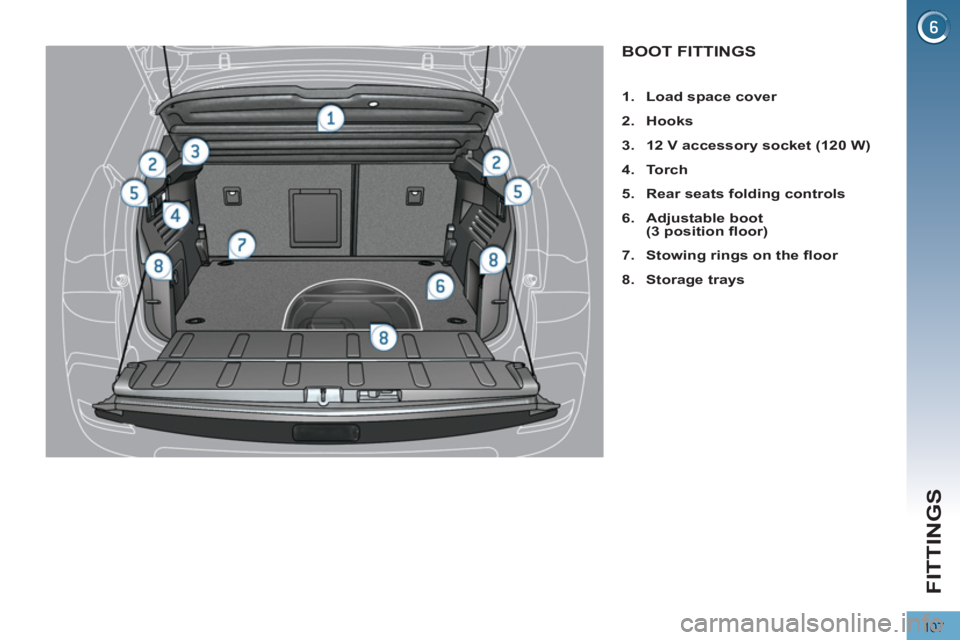
107
FITTINGS
BOOT FITTINGS
1.
Load space cover
2.
Hooks
3.
12 V accessory socket (120 W)
4.
To r c h
5.
Rear seats folding controls
6.
Adjustable boot
(3 position fl oor )
7.
Stowing rings on the fl oor
8.
Storage trays
Page 110 of 328
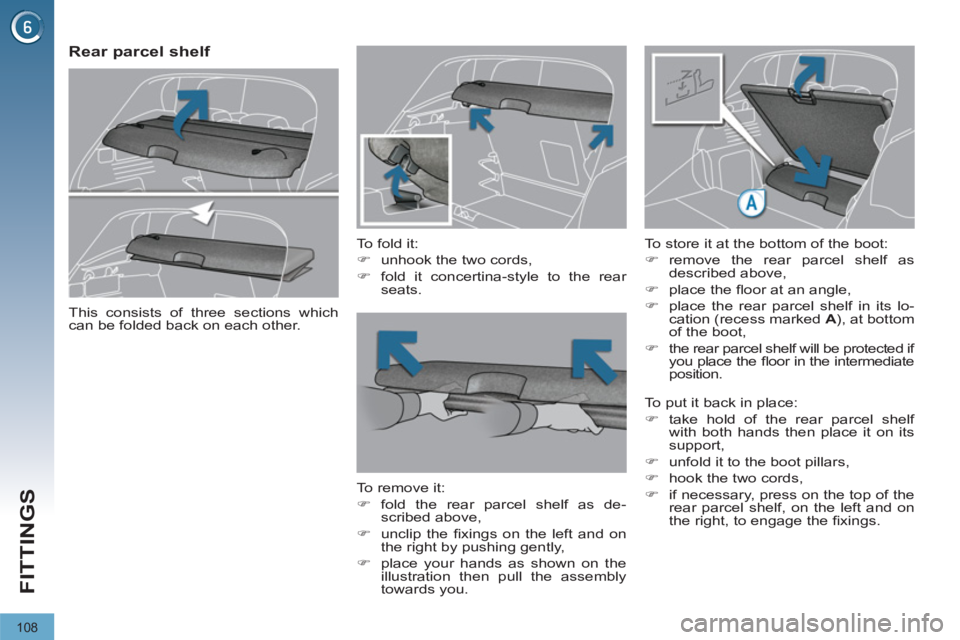
108
FITTINGS
Rear parcel shelf
To fold it:
�)
unhook the two cords,
�)
fold it concertina-style to the rear
seats.
To remove it:
�)
fold the rear parcel shelf as de-
scribed above,
�)
unclip the fi xings on the left and on
the right by pushing gently,
�)
place your hands as shown on the
illustration then pull the assembly
towards you.
To store it at the bottom of the boot:
�)
remove the rear parcel shelf as
described above,
�)
place the fl oor at an angle,
�)
place the rear parcel shelf in its lo-
cation (recess marked A
), at bottom
of the boot,
�)
the rear parcel shelf will be protected if
you place the fl oor in the intermediate
position.
This consists of three sections which
can be folded back on each other.
To put it back in place:
�)
take hold of the rear parcel shelf
with both hands then place it on its
support,
�)
unfold it to the boot pillars,
�)
hook the two cords,
�)
if necessary, press on the top of the
rear parcel shelf, on the left and on
the right, to engage the fi xings.
Page 111 of 328

109
FITTINGS
When changing a wheel
The hooks facilitate access
to the spare wheel, retain-
ing the boot carpet by means of the
two cords.
The hooks can be used to secure shop-
ping bags.
Hooks
�)
To connect a 12 V accessory (max
power: 120 W), remove the cap and
connect an appropriate adaptor.
�)
Turn the key to the ignition position.
12 V accessory socket
Luggage retaining net
Hooked onto the stowing rings on the
movable boot fl oor, the luggage retaining
net available as an accessory enables
you to secure your luggage.
Observe the loads indicated on the side
of the boot, in accordance with the posi-
tion of the movable fl oor.
For safety reasons in case of sharp
braking, we recommend that heavy ob-
jects are placed on the fl oor as close as
possible to the back of the rear seats.
Page 113 of 328
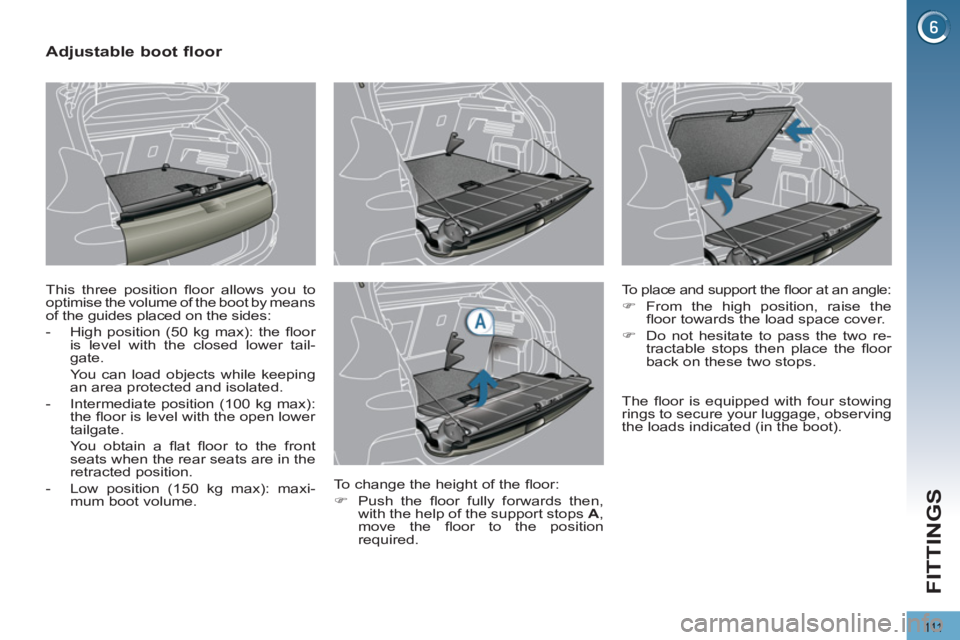
111
FITTINGS
Adjustable boot floor
This three position fl oor allows you to
optimise the volume of the boot by means
of the guides placed on the sides:
- High position (50 kg max): the fl oor
is level with the closed lower tail-
gate.
You can load objects while keeping
an area protected and isolated.
- Intermediate position (100 kg max):
the fl oor is level with the open lower
tailgate.
You obtain a fl at fl oor to the front
seats when the rear seats are in the
retracted position.
- Low position (150 kg max): maxi-
mum boot volume.
To place and support the fl oor at an angle:
�)
From the high position, raise the
fl oor towards the load space cover.
�)
Do not hesitate to pass the two re-
tractable stops then place the fl oor
back on these two stops.
To change the height of the fl oor:
�)
Push the fl oor fully forwards then,
with the help of the support stops A
,
move the fl oor to the position
required.
The fl oor is equipped with four stowing
rings to secure your luggage, observing
the loads indicated (in the boot).
Page 126 of 328
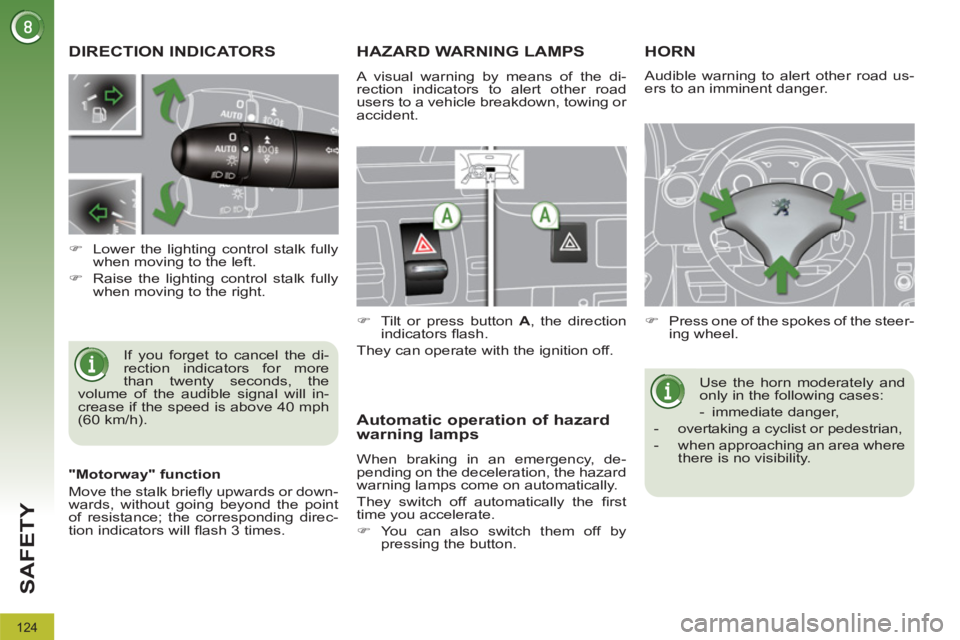
124
SAFETY
DIRECTION INDICATORS
If you forget to cancel the di-
rection indicators for more
than twenty seconds, the
volume of the audible signal will in-
crease if the speed is above 40 mph
(60 km/h).
�)
Lower the lighting control stalk fully
when moving to the left.
�)
Raise the lighting control stalk fully
when moving to the right.
HAZARD WARNING LAMPS
A visual warning by means of the di-
rection indicators to alert other road
users to a vehicle breakdown, towing or
accident.
�)
Tilt or press button A
, the direction
indicators fl ash.
They can operate with the ignition off.
Automatic operation of hazard
warning lamps
When braking in an emergency, de-
pending on the deceleration, the hazard
warning lamps come on automatically.
They switch off automatically the fi rst
time you accelerate.
�)
You can also switch them off by
pressing the button.
HORN
�)
Press one of the spokes of the steer-
ing wheel.
Use the horn moderately and
only in the following cases:
- immediate danger,
- overtaking a cyclist or pedestrian,
- when approaching an area where
there is no visibility.
Audible warning to alert other road us-
ers to an imminent danger.
"Motorway" function
Move the stalk briefl y upwards or down-
wards, without going beyond the point
of resistance; the corresponding direc-
tion indicators will fl ash 3 times.
Page 134 of 328
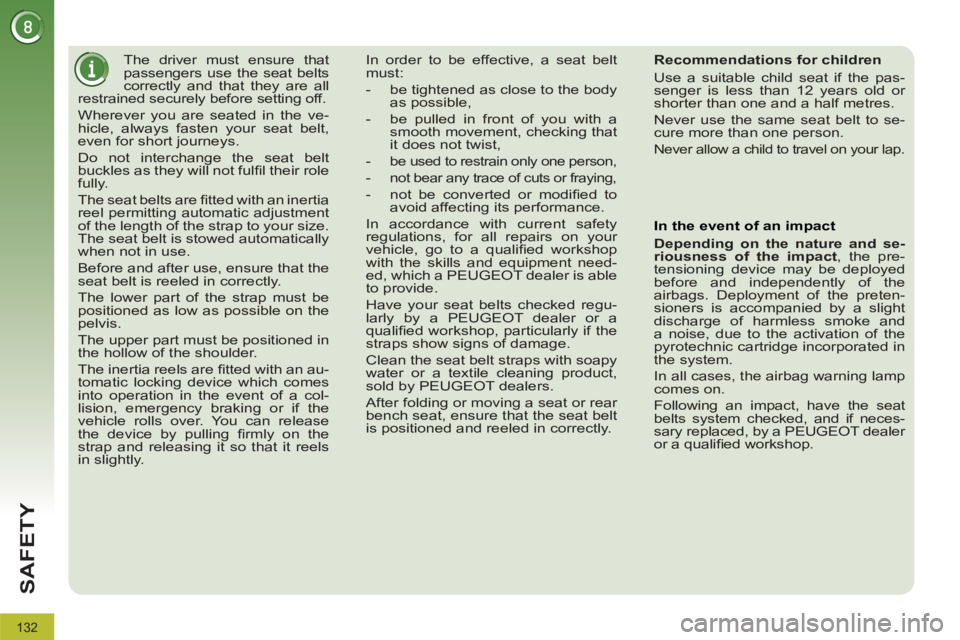
132
SAFETY
The driver must ensure that
passengers use the seat belts
correctly and that they are all
restrained securely before setting off.
Wherever you are seated in the ve-
hicle, always fasten your seat belt,
even for short journeys.
Do not interchange the seat belt
buckles as they will not fulfi l their role
fully.
The seat belts are fi tted with an inertia
reel permitting automatic adjustment
of the length of the strap to your size.
The seat belt is stowed automatically
when not in use.
Before and after use, ensure that the
seat belt is reeled in correctly.
The lower part of the strap must be
positioned as low as possible on the
pelvis.
The upper part must be positioned in
the hollow of the shoulder.
The inertia reels are fi tted with an au-
tomatic locking device which comes
into operation in the event of a col-
lision, emergency braking or if the
vehicle rolls over. You can release
the device by pulling fi rmly on the
strap and releasing it so that it reels
in slightly. In order to be effective, a seat belt
must:
- be tightened as close to the body
as possible,
- be pulled in front of you with a
smooth movement, checking that
it does not twist,
-
be used to restrain only one person,
- not bear any trace of cuts or fraying,
- not be converted or modifi ed to
avoid affecting its performance.
In accordance with current safety
regulations, for all repairs on your
vehicle, go to a qualifi ed workshop
with the skills and equipment need-
ed, which a PEUGEOT dealer is able
to provide.
Have your seat belts checked regu-
larly by a PEUGEOT dealer or a
qualifi ed workshop, particularly if the
straps show signs of damage.
Clean the seat belt straps with soapy
water or a textile cleaning product,
sold by PEUGEOT dealers.
After folding or moving a seat or rear
bench seat, ensure that the seat belt
is positioned and reeled in correctly.
Recommendations for children
Use a suitable child seat if the pas-
senger is less than 12 years old or
shorter than one and a half metres.
Never use the same seat belt to se-
cure more than one person.
Never allow a child to travel on your lap.
In the event of an impact
Depending on the nature and se-
riousness of the impact
, the pre-
tensioning device may be deployed
before and independently of the
airbags. Deployment of the preten-
sioners is accompanied by a slight
discharge of harmless smoke and
a noise, due to the activation of the
pyrotechnic cartridge incorporated in
the system.
In all cases, the airbag warning lamp
comes on.
Following an impact, have the seat
belts system checked, and if neces-
sary replaced, by a PEUGEOT dealer
or a qualifi ed workshop.